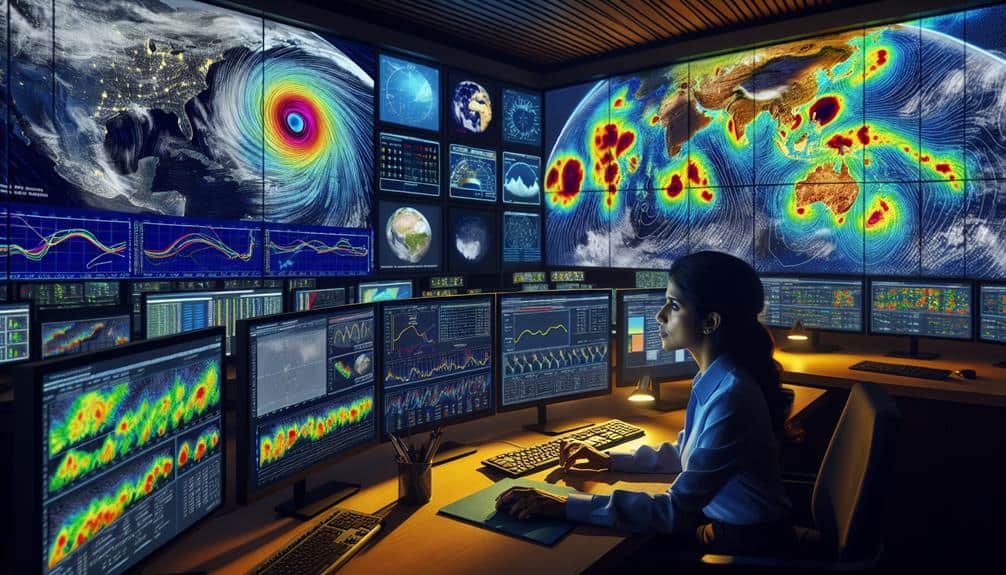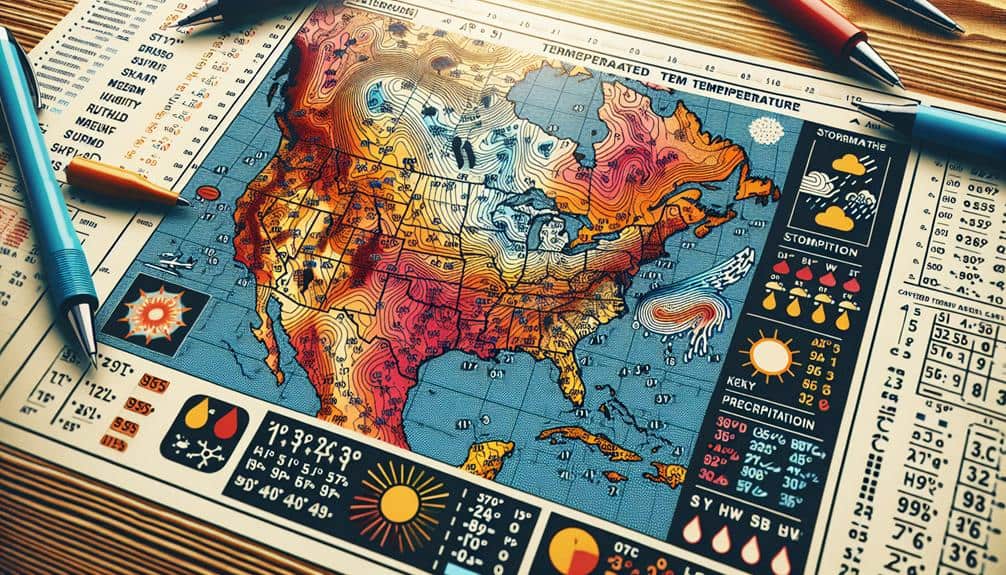We collect historical weather data, analyzing temperature, humidity, and wind speeds using regression and time-series analysis. By integrating satellite imagery, we identify essential cloud patterns and temperature changes to predict storm development. Evaluating weather models for accuracy guarantees reliable forecasts, while monitoring atmospheric pressure provides vital weather pattern indicators. Real-time temperature analysis, combined with historical trends, offers insights into atmospheric stability. Examining wind patterns helps determine storm direction and intensity, and thorough precipitation data assessment identifies spatial rainfall variations. All these steps are necessary for precise storm forecasting, and there's much more to explore on each technique.
Key Points
- Utilize historical and real-time weather data for comprehensive storm pattern analysis.
- Leverage satellite imagery to monitor cloud patterns and temperature changes for accurate storm predictions.
- Assess weather models using performance metrics like RMSE and MAE to ensure forecast reliability.
- Analyze atmospheric pressure variations to predict storm development and movements.
Gather Historical Data
To accurately predict storms, we'll first need to gather historical weather data from reliable meteorological databases. Our primary focus is on obtaining extensive datasets that include temperature, humidity, wind speeds, and precipitation levels. This data forms the backbone of our forecasting models, enabling us to identify patterns and trends that are vital for predicting future weather events.
We should employ advanced statistical analysis methods to sift through the historical data. Techniques such as regression analysis, time-series analysis, and clustering can help us pinpoint anomalies and recurring weather patterns. By applying these methods, we can refine our models to enhance their predictive accuracy.
Data visualization techniques are equally important in this process. Visual tools like heatmaps, scatter plots, and time-lapse graphs allow us to interpret complex data sets more intuitively. By visualizing data, we can quickly identify trends and outliers that may not be evident through raw numbers alone.
Combining these statistical and visualization approaches, we create a robust framework for storm forecasting. This empowers us to make informed decisions and take proactive measures, ensuring we're not merely reacting to weather conditions but anticipating them with greater precision.
Utilize Satellite Imagery
We'll leverage satellite imagery to enhance our storm forecasting accuracy.
By identifying cloud patterns, monitoring temperature changes, and tracking storm movements, we can predict storm development with greater precision.
This data-driven approach enables us to make timely and informed decisions.
Identify Cloud Patterns
By analyzing satellite imagery, we can identify distinct cloud patterns that are vital for accurate storm forecasting. When we examine cloud cover, certain formations signify the early stages of storm formation. For example, cumulonimbus clouds with well-defined anvil tops often indicate severe weather potential. We must pay close attention to these patterns as they evolve.
Satellite data also provides insights into humidity levels, which are essential for understanding storm dynamics. High humidity in the lower and mid-troposphere can fuel storm development, while dry air intrusions can inhibit it. By cross-referencing cloud patterns with humidity levels, we can better predict the likelihood and intensity of storms.
Furthermore, observing lightning activity through satellite imagery helps us pinpoint areas of strong convective activity. Intense lightning clusters often precede severe weather events, including thunderstorms and tornadoes. By correlating these signals with observed cloud patterns, we can enhance our storm forecasting accuracy.
Monitor Temperature Changes
Monitoring temperature changes through satellite imagery enables us to detect thermal anomalies that are vital for predicting storm development and intensity. By leveraging high-resolution satellite data, we can identify subtle shifts in surface and atmospheric temperatures, which often precede storm formation. These temperature anomalies, when analyzed in conjunction with other meteorological parameters, provide crucial insights into the potential severity and trajectory of impending storms.
We utilize advanced algorithms to process satellite imagery, extracting precise temperature data trends over time. This allows us to observe patterns that mightn't be evident through ground-based observations alone. For instance, a sudden increase in sea surface temperature can indicate the onset of a tropical cyclone, while rapid cooling in a specific region may signal the dissipation of storm activity.
Understanding the impact of climate change on temperature variations is also essential. As global temperatures rise, the frequency and intensity of storms are affected, making it imperative to integrate climate change impact assessments into our forecasting models. By continuously monitoring these temperature changes, we enhance our ability to forecast storms accurately, thereby empowering communities to make informed decisions and maintain their freedom in the face of natural disasters.
Track Storm Movements
Tracking storm movements through satellite imagery provides us with real-time data essential for predicting storm trajectories and potential impact zones. By analyzing these images, we can assess storm intensity and its development over time. High-resolution satellite data allows us to monitor key indicators such as cloud formation, wind patterns, and precipitation rates. This precise information enables meteorologists to make accurate forecasts.
We rely on both geostationary and polar-orbiting satellites to gather detailed data. Geostationary satellites offer continuous coverage of specific regions, while polar-orbiting satellites provide specific snapshots of the entire globe. Combining data from these sources gives us a full picture of a storm's progression.
With storm intensity and movement data at our fingertips, we can issue timely warnings and prepare for emergency response. Real-time updates on a storm's path help local authorities to mobilize resources and implement evacuation plans when necessary. This proactive approach minimizes damage and saves lives.
Analyze Weather Models

When we analyze weather models, we must prioritize model accuracy assessment to guarantee reliable forecasts.
By interpreting ensemble forecasts, we can better understand the range of possible storm outcomes and reduce uncertainty.
This approach allows us to refine predictive capabilities and enhance decision-making processes.
Model Accuracy Assessment
To affirm precise storm forecasting, we must thoroughly evaluate the performance metrics of various weather models. By conducting comprehensive model evaluation and data comparison, we can pinpoint strengths and weaknesses in each model's predictive capabilities. This process guarantees that we rely on the most dependable tools for our forecasts.
Accuracy validation is a critical step in this process. We systematically compare model outputs against historical data and real-time observations to assess how well each model predicts storm events. Forecast validation involves comparing predicted outcomes with observed weather patterns, allowing us to quantify the models' performance.
We use a variety of statistical metrics, such as Root Mean Square Error (RMSE) and Mean Absolute Error (MAE), to measure the deviations between predicted and observed values. These metrics help us identify areas where a model may underperform, guiding us towards necessary adjustments or alternative models that better suit our needs.
Ensemble Forecast Interpretation
Building on our model accuracy assessment, we now focus on interpreting ensemble forecasts, a method that leverages multiple weather models to enhance predictive reliability.
By evaluating a collection of forecasts from different models, we can better understand the range of possible outcomes and their likelihood. This process, known as ensemble model evaluation, is essential for refining storm forecasts and reducing uncertainty.
To effectively interpret ensemble forecasts, we should:
- Compare Model Outputs: Evaluate the outputs of various models side-by-side to identify consensus and divergence points.
- Utilize Probabilistic Forecasts: Translate deterministic predictions into probabilistic terms to convey the likelihood of different scenarios.
- Apply Data Visualization Techniques: Implement tools like spaghetti plots, box plots, and heat maps to visually represent ensemble data and highlight key patterns.
- Assess Temporal Consistency: Track how ensemble forecasts evolve over time to detect trends and shifts in predictions.
Monitor Atmospheric Pressure
Monitoring atmospheric pressure is essential for accurately predicting storm development and movement. By keeping a close eye on pressure trends, we can enhance our forecasting accuracy and provide more reliable information.
Atmospheric pressure is a critical indicator of weather patterns; changes in pressure often precede significant weather events, including storms.
We should focus on understanding both high and low-pressure systems. High-pressure systems, typically associated with fair weather, can influence the path of storm systems by acting as barriers. Conversely, low-pressure systems are often the breeding grounds for storm development due to their rising air and convergence of wind.
By analyzing the spatial and temporal variations in these pressure systems, we can gain insights into potential storm formation and trajectories.
High-resolution barometric data, collected from ground stations and satellites, allow us to monitor these shifts precisely. Advanced modeling tools enable us to simulate pressure trends over time, further improving our forecasting accuracy.
Additionally, integrating pressure data with other meteorological variables, such as humidity and wind speed, provides a more detailed picture of the atmospheric conditions conducive to storm development.
Track Temperature Changes

Tracking temperature changes is essential for storm forecasting as temperature variations directly influence atmospheric stability and storm intensity. By monitoring temperature fluctuations, we can gain insights into the development and potential paths of storms.
To effectively track these changes, consider the following steps:
- Analyze Historical Data Trends: Reviewing historical temperature data helps us understand long-term climate variation and identify any abnormal weather patterns that might indicate storm activity.
- Monitor Real-Time Temperature Readings: Utilizing advanced meteorological instruments, we can obtain real-time temperature data, which is critical for timely and accurate storm forecasts.
- Compare Surface and Upper-Level Temperatures: By comparing temperature readings from different atmospheric levels, we can assess atmospheric stability. Significant temperature differences often signal potential storm development.
- Incorporate Satellite Data: Satellite imagery provides a thorough view of temperature distributions across large areas, helping us to detect and track temperature anomalies that may lead to storm formation.
These methods allow us to stay ahead of temperature fluctuations and predict storms more accurately. Understanding the interplay between temperature changes and weather patterns empowers us to make informed decisions and maintain our freedom to respond proactively to impending weather events.
Examine Wind Patterns
Understanding wind patterns is vital for storm forecasting as they influence storm direction, intensity, and development. We must start by conducting a thorough wind direction analysis. By examining wind vectors, we can determine the paths storms are likely to take. Winds from different directions bring varying levels of moisture and temperature, affecting storm development.
In addition to direction, wind speed patterns are pivotal. High wind speeds can indicate the presence of strong pressure gradients. This information helps us anticipate the storm's intensity. We utilize anemometers and satellite data to measure wind speeds at various altitudes, providing a three-dimensional view of the atmosphere. These measurements allow us to detect jet streams and wind shear, critical factors in storm dynamics.
We should also consider temporal changes in wind patterns. By analyzing historical wind data, we can identify trends and anomalies that may signal developing storm conditions. For instance, a sudden increase in wind speed at higher altitudes can indicate an approaching frontal system.
Evaluate Precipitation Data

To accurately forecast storms, we must rigorously analyze precipitation data to understand the distribution, intensity, and types of precipitation associated with different meteorological conditions. This analysis allows us to predict potential flooding, storm severity, and other critical weather conditions with precision.
First, we need to assess rainfall distribution to determine how precipitation varies spatially over a region. This involves:
- Collecting data from rain gauges placed at various points to measure actual rainfall.
- Analyzing radar imagery to visualize precipitation patterns over time and space.
- Using satellite data to complement ground-based measurements, offering a broader view of precipitation distribution.
- Employing numerical weather prediction models that incorporate precipitation data to forecast future conditions.
Next, we examine the intensity of precipitation. By analyzing radar imagery, we can estimate the rate at which rain is falling, which helps identify areas at risk of heavy downpours and flash flooding.
Lastly, understanding different types of precipitation—whether rain, snow, sleet, or hail—enables us to tailor our forecasts to specific conditions, improving accuracy.
Frequently Asked Questions
How Can Data From Weather Balloons Improve Storm Forecasting Accuracy?
Imagine weather balloons soaring into the sky, capturing essential atmospheric data. They provide us with temperature, humidity, and wind speed at various altitudes, enhancing our storm forecasting accuracy and helping us predict severe weather events more effectively.
What Role Do Ocean Temperatures Play in Storm Formation?
We need to understand the impact of oceans on storm development. Temperature anomalies in ocean waters provide critical data, influencing storm intensity and formation. Analyzing these anomalies allows us to predict and prepare for severe weather more accurately.
How Do Climatological Patterns Affect Storm Prediction?
Remember how chess strategies change based on the board's layout? Similarly, climatological patterns impact storm dynamics by altering atmospheric conditions. Understanding these patterns helps us predict storm paths more accurately, providing freedom from unexpected weather disruptions.
What Software Tools Are Recommended for Meteorological Data Analysis?
We recommend using software like Python with libraries for data visualization and statistical analysis, TensorFlow for machine learning, and ArcGIS for GIS mapping. These tools empower us to analyze meteorological data with precision and efficiency.
How Can Crowd-Sourced Weather Data Be Integrated Into Forecasting Models?
Harnessing the power of a digital hive, we can use mobile apps and community engagement for crowd-sourced weather data. Machine learning aids seamless data integration, enhancing forecasting models' accuracy and offering us the freedom to predict storms better.

